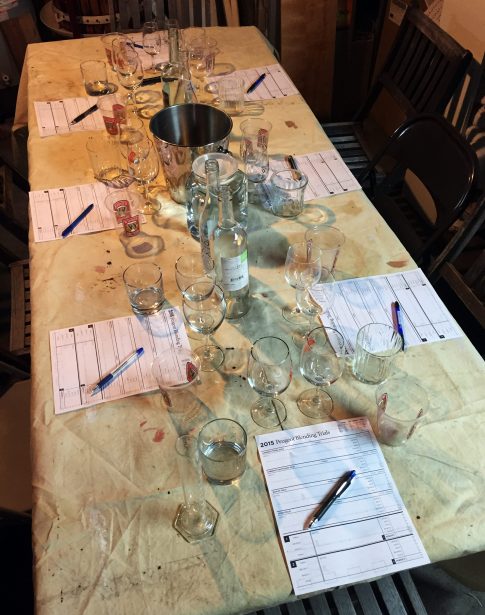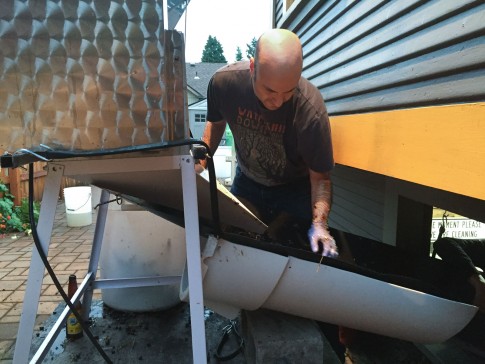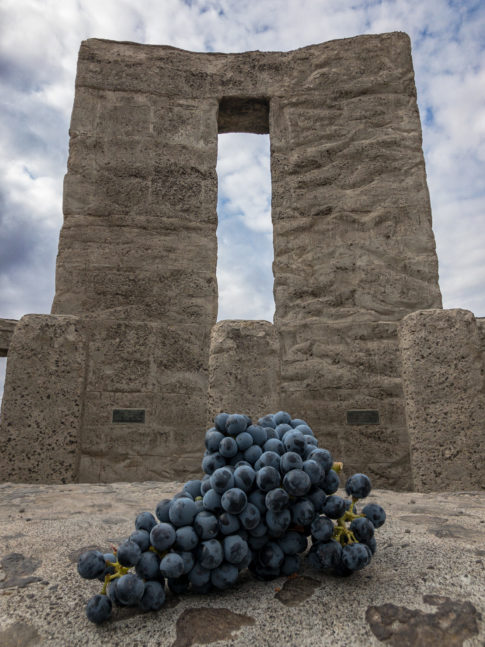Archive for the 'Winemaking' Category
The 2015 Peugeot Blend
 We have met, deliberated and spat, so herewith, your 2015 Peugeot blend:
We have met, deliberated and spat, so herewith, your 2015 Peugeot blend:
47% Cabernet Franc
40% Cabernet Sauvignon
8% Merlot
5% Syrah
A round of applause, please for the Garagistes who bravely shouldered the burden of trialing this out last weekend. I think we had a great group: lots of discussion, good ideas from everyone, and collegial differences of opinion.
We’ve done blending trials like this since 2006, the first Peugeot, but every year I’m amazed we actually get something we like – and with pretty much unanimous consent.
This year was no different. The Cab Franc had a higher than normal acidity, as well as more alcohol than we’d like, so right away the lynchpin of every Peugeot was in question. After tasting through the component wines individually, we waded into blending, but after 2 blends I found myself wondering if we’d ever wrangle these distinct personalities into balance.
But again, I shouldn’t have feared: by the 4th blend – not coincidentally when we started adding Syrah into the mix – things were starting to fall into place. To me, it was a question of controlling the acidity the Franc brought to the table, getting the right (but not too much!) amount of fruit (via the Merlot and Syrah), and controlling the amount of tannin throughout (largely the Cab Sauv’s contribution, in addition to weight in general).
Anyway, the final wine kind of knocked our socks off. It’s really got a lot going on in the mouth – lots of things firing at once, but in concert – and it smells heavenly.
Next up: the Labourier!
No commentsThe cabernet long-soak: Day 46 & Press
This thing is ready. What was increasingly bitter and awkward tannins have, like a caterpillar, transformed into a smooth, silky butterfly almost overnight.
There’s still some EA in the cap, but since EA is a surface dweller (it needs oxygen to survive), we scrape off the top 1-2″ before press. Then we let the free run drain from the bottom of the fermenter before shoveling out the grape must into the press, setting it aside so that even if the pressed grapes are still stained with a bit of EA, we’ll at least have clean, lovely free run.
But as far as we can tell as the actual press progresses, we’ve scraped off any compromised fruit: this stuff tastes and smells fantastic!
No commentsThe Cabernet long-soak: Day 30
As of today, we’re approx 28-32 days out from sealing the Cab away. So now that we’re close to our guess about when it’ll turn, we need to start really paying attention.
Of course, we’ve been tasting/smelling the Cab every 4-5 days. We’re getting some EA on the surface – a little disturbing, for sure – but a stern talking to with argon and sulfite sprayed over the cap seems to have really knocked it to its knees. In fact, when we bellows’d the plastic this morning, it actually smelled close to pretty straight.
And the wine itself, below the cap, continues to be totally clean. But it has been changing — today it had evolved more of a planty, stemmy aspect, something we both felt was interesting (that is to say, not a defect). Maybe a bit more richness.
Still, it’s hard to say where this thing is in its evolution. The acidity is high enough, that for me at least, it’s hard to get a read on the tannins. Right now, they taste just fine to me, though they should be getting increasingly astringent up to the turn. We’ll definitely keep an eye on it…
No commentsAnalysis and update: Mourvedre, Cabernet, and Sangiovese Rosato

That’s two Mourvedres in the corner, the Sangiovese Rose along the far wall, and the sealed Cab Sauv in the foreground. Here’s what’s still percolating down in the winery, and what the heck we’re doing about it:
Mourvèdre
After a rocky start — a wild ride of wine nutrient issues — it’s smelling lovely and almost done: this morning, about 3 brix on one, and 3.7 brix on the other. My guess is that it’ll be ready to press Tuesday, maybe Wednesday.
Because we split this ferment into two smaller vessels, there was less thermal mass, and therefore the MV didn’t reach the temperature it usually does. This year, I’m experimenting with cooler, longer ferments for all our grapes (to emphasize fragrance all around, the theory goes), but this has been exceptionally cool, only barely getting into the 70s. So a couple days ago, I wrapped them with an electric blanket and applied some gentle temperature, the goal being to get it at least into the upper 70s so we get at least a tad more body and richness. So far so good: this morning, we’re at 75.
I don’t think we want to let this one go completely dry — until the cap falls, that is, extracting every last bit of skin contact we can — because to me, the MV is all about fragrance and balance. But I’ll be tasting it over the next few days to keep an eye on it.
Sangiovese Rosato
Man does this smell lovely. It’s almost done, too — maybe 2.2 brix. Unlike the reds, though, I don’t want to let this one go completely dry in the open-topped fermenter it’s currently in — too much possible oxygen exposure as the ferment dies down and produces less and less CO2 to protect itself.
So probably tomorrow I’ll be racking it off into carboys to finish its ferment in a more controlled environment.
Cabernet Sauvignon
The deal is sealed! I’ve had it gassed and sealed with bungees for a few days now, but the bungees don’t give a complete seal. So yesterday we opened it up to check it — and it was still fermenting a bit! We punched it down and tasted it, and already the tannins are rising, nice and chalky/chocolately. But then we regassed it with argon, and we formally sealed it up with duct-tape.
So now we wait for a bit. As I mentioned in an earlier post, the last time we did this we pressed approx 40 days after sealing. Counting from the first day I sealed this sucker, that would be November 15. We’ll be checking it before then, though. I’d say the first check should probably happen 3 weeks out, or around October 27.
No commentsThe bittersweetness of the last crush

Jeremy valiantly takes on the messiest job at our last crush of 2015: keeping the destemmer flowing. Luckily, after four harvest evenings spanning 10 varietals (including this pitch-perfect Mourvèdre), we had this crush thing pretty much down, and we were eating and drinking wine by 7:45.
But now, while our 2015 season isn’t over, everything starts to contract: the process moves inside for fermentation, punchdowns and pressings over the next few weeks, so smaller groups are required to coax our grapes toward wine. Ultimately, it’ll end with what Jeremy nudged down the chute last night, as the Mourvèdre eases across the finish line and into the press in an otherwise silent basement a couple of weeks from now.
That’s just how it works, and that’s fine. But as you might guess, for me this moment is bittersweet, marking as it does the end of something, even though there’s still plenty more to come. The early-morning runs out the Gorge into the sunrise, through the cow shit and fertilizer haze of Toppenish and then up out of it into the sun and majestic silence of our vineyards; walking the rows and teasing grapes into my mouth, hoping I’m aware enough to notice the moment when all the tumblers of fruit, acid, depth and balance click and align, unlocking the perfect pick; eight hours of inspiring and all-to-rare one-on-one with whoever goes with me on the trip; and best of all, coming back into the arms of an incredible, diverse and multi-generational group of Garagistes as we all bend our backs and, in a kind of focused chaos, somehow make something beautiful together.
I have to say I kind of live for that. In fact, if making wine didn’t involve it, I’m not sure I’d still be making wine 21 harvests in.
Because the arc of a vintage is like the arc of a life. It begins with a big, wide embrace of people and movement, of everything new, of whatever is now, then slowly quiets and contracts, like Haydn’s Symphony 45, until there’s only one violinist left on the stage.
Except we winemakers — we Garagistes — get to cheat all that. Next September, we’ll point our truck east, out the Gorge, and live that messy, magnificent arc all over again. Already, I can’t wait.
No commentsAnalysis: Cabernet, Grenache, and Sangiovese juice and plan
Now that we’ve crushed what we brought in a few days ago, let it sit long enough to even out, and sent samples to the lab for analysis, here’s what I’m thinking about our Cab Sauv, Grenache and Sangiovese.
Cabernet Sauvignon
In short, I think we nailed the pick here: we got the spot-on flavors we wanted without having to go too high in sugar, and at a cost of too much loss of acidity. Left to itself, though, this must would make a 14.8% wine, a bit too high for my taste. So we’ll rehydrate, targeting 14%. Depending on the varietal, I’m generally targeting alcohols between 13.5 and 14%, which seems to be a sweet spot for us. Here, it’s Cabernet — a wine whose nature is bigness — so the target alcohol is on the high side of our range.
That said, once fermentation is over, and the wine’s been racked and aged for 6-8 months (during which time some evaporation will occur), we’ll re-assess the alcohol by how the wine tastes, and make any further water additions as necessary. That’s the same for all of our wines, actually — another reason I shoot a bit high alcohol-size right now – we can always drop alcohol; harder to add it.
Grenache
As we suspected, this critter came in pretty ripe. THat’s in large part because, in the vineyard, the Grenache was really odd this year: it achieved taste-ripeness long before its skins and seeds did. So we had to wait for depth and color, and this is the result. I think it tastes good, but no we really need to open the floodgates on this sucker: left without monkeying, this would be a 17% alcohol wine — if the yeasts could even take it that high before killing themselves in a drunken melee.
So the rehydration here will be pretty huge, targeting 14%. That’s too high for Grenache, but the move is so large here that I want to be conservative; we can always (and probably will) adjust later.
Its pH is also way high, not surprisingly considering the level of sugar (sugar rises as acid goes down as grapes ripen). So that too will be smacked back significantly so we not only have some balance in the wine, it’s protected microbially.
Sangiovese
Pretty lovely numbers as is, as the taste of the juice reflects. The acidity is right where we want it (Sangiovese is always naturally more acidic than the other reds we make). Then I’ll rehydrate just a bit to coax it under 14%.
Sangiovese Rosato
This Rosé is an experiment, but at least in terms of brix and pH, the numbers for Sangio apply here — though what you do with them is different. The acidity you want for a red isn’t the same as for a rose (which is closer to a white wine temperamentally), so I’ll push the acidity back down to 3.45 to start – and I’ll bet we’ll push it lower before we bottle it. Similarly, I’ll push the alcohol lower than for the red; for now, I’ll shoot for 13.6% alcohol.
All in all, the Cab’s going to be excellent, the Grenache its usual relatively uncomplicated but fun self, and the Sangiovese will be awesome, as it always seems to be from this vineyard.
No comments
